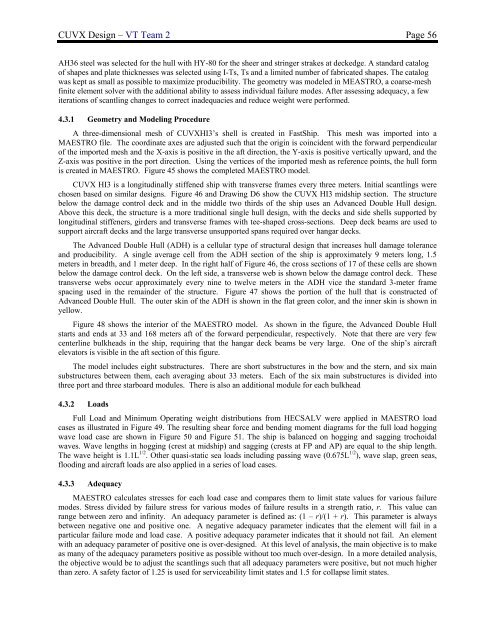CUVX Design Report - the AOE home page - Virginia Tech
CUVX Design Report - the AOE home page - Virginia Tech
CUVX Design Report - the AOE home page - Virginia Tech
You also want an ePaper? Increase the reach of your titles
YUMPU automatically turns print PDFs into web optimized ePapers that Google loves.
<strong>CUVX</strong> <strong>Design</strong> – VT Team 2 Page 56AH36 steel was selected for <strong>the</strong> hull with HY-80 for <strong>the</strong> sheer and stringer strakes at deckedge. A standard catalogof shapes and plate thicknesses was selected using I-Ts, Ts and a limited number of fabricated shapes. The catalogwas kept as small as possible to maximize producibility. The geometry was modeled in MEASTRO, a coarse-meshfinite element solver with <strong>the</strong> additional ability to assess individual failure modes. After assessing adequacy, a fewiterations of scantling changes to correct inadequacies and reduce weight were performed.4.3.1 Geometry and Modeling ProcedureA three-dimensional mesh of <strong>CUVX</strong>HI3’s shell is created in FastShip. This mesh was imported into aMAESTRO file. The coordinate axes are adjusted such that <strong>the</strong> origin is coincident with <strong>the</strong> forward perpendicularof <strong>the</strong> imported mesh and <strong>the</strong> X-axis is positive in <strong>the</strong> aft direction, <strong>the</strong> Y-axis is positive vertically upward, and <strong>the</strong>Z-axis was positive in <strong>the</strong> port direction. Using <strong>the</strong> vertices of <strong>the</strong> imported mesh as reference points, <strong>the</strong> hull formis created in MAESTRO. Figure 45 shows <strong>the</strong> completed MAESTRO model.<strong>CUVX</strong> HI3 is a longitudinally stiffened ship with transverse frames every three meters. Initial scantlings werechosen based on similar designs. Figure 46 and Drawing D6 show <strong>the</strong> <strong>CUVX</strong> HI3 midship section. The structurebelow <strong>the</strong> damage control deck and in <strong>the</strong> middle two thirds of <strong>the</strong> ship uses an Advanced Double Hull design.Above this deck, <strong>the</strong> structure is a more traditional single hull design, with <strong>the</strong> decks and side shells supported bylongitudinal stiffeners, girders and transverse frames with tee-shaped cross-sections. Deep deck beams are used tosupport aircraft decks and <strong>the</strong> large transverse unsupported spans required over hangar decks.The Advanced Double Hull (ADH) is a cellular type of structural design that increases hull damage toleranceand producibility. A single average cell from <strong>the</strong> ADH section of <strong>the</strong> ship is approximately 9 meters long, 1.5meters in breadth, and 1 meter deep. In <strong>the</strong> right half of Figure 46, <strong>the</strong> cross sections of 17 of <strong>the</strong>se cells are shownbelow <strong>the</strong> damage control deck. On <strong>the</strong> left side, a transverse web is shown below <strong>the</strong> damage control deck. Thesetransverse webs occur approximately every nine to twelve meters in <strong>the</strong> ADH vice <strong>the</strong> standard 3-meter framespacing used in <strong>the</strong> remainder of <strong>the</strong> structure. Figure 47 shows <strong>the</strong> portion of <strong>the</strong> hull that is constructed ofAdvanced Double Hull. The outer skin of <strong>the</strong> ADH is shown in <strong>the</strong> flat green color, and <strong>the</strong> inner skin is shown inyellow.Figure 48 shows <strong>the</strong> interior of <strong>the</strong> MAESTRO model. As shown in <strong>the</strong> figure, <strong>the</strong> Advanced Double Hullstarts and ends at 33 and 168 meters aft of <strong>the</strong> forward perpendicular, respectively. Note that <strong>the</strong>re are very fewcenterline bulkheads in <strong>the</strong> ship, requiring that <strong>the</strong> hangar deck beams be very large. One of <strong>the</strong> ship’s aircraftelevators is visible in <strong>the</strong> aft section of this figure.The model includes eight substructures. There are short substructures in <strong>the</strong> bow and <strong>the</strong> stern, and six mainsubstructures between <strong>the</strong>m, each averaging about 33 meters. Each of <strong>the</strong> six main substructures is divided intothree port and three starboard modules. There is also an additional module for each bulkhead4.3.2 LoadsFull Load and Minimum Operating weight distributions from HECSALV were applied in MAESTRO loadcases as illustrated in Figure 49. The resulting shear force and bending moment diagrams for <strong>the</strong> full load hoggingwave load case are shown in Figure 50 and Figure 51. The ship is balanced on hogging and sagging trochoidalwaves. Wave lengths in hogging (crest at midship) and sagging (crests at FP and AP) are equal to <strong>the</strong> ship length.The wave height is 1.1L 1/2 . O<strong>the</strong>r quasi-static sea loads including passing wave (0.675L 1/2 ), wave slap, green seas,flooding and aircraft loads are also applied in a series of load cases.4.3.3 AdequacyMAESTRO calculates stresses for each load case and compares <strong>the</strong>m to limit state values for various failuremodes. Stress divided by failure stress for various modes of failure results in a strength ratio, r. This value canrange between zero and infinity. An adequacy parameter is defined as: (1 – r)/(1 + r). This parameter is alwaysbetween negative one and positive one. A negative adequacy parameter indicates that <strong>the</strong> element will fail in aparticular failure mode and load case. A positive adequacy parameter indicates that it should not fail. An elementwith an adequacy parameter of positive one is over-designed. At this level of analysis, <strong>the</strong> main objective is to makeas many of <strong>the</strong> adequacy parameters positive as possible without too much over-design. In a more detailed analysis,<strong>the</strong> objective would be to adjust <strong>the</strong> scantlings such that all adequacy parameters were positive, but not much higherthan zero. A safety factor of 1.25 is used for serviceability limit states and 1.5 for collapse limit states.
















